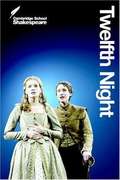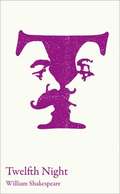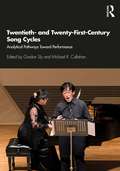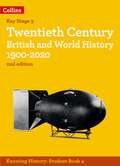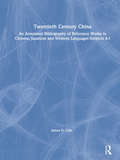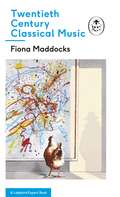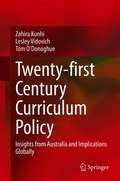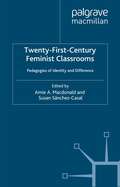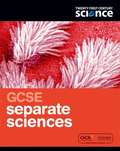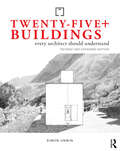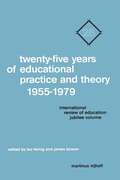- Table View
- List View
Tweak to Transform: Improving teaching: a practical handbook for school leaders
by Mike HughesImproving teaching is the key to genuine and sustainable school improvement. Improvement involves persuading teachers to change and develop their practice but, as anyone who has ever tried will testify, this is far from easy. The focus of Tweak to Transform is what head teachers and school leaders can do to manage the change process and improve the quality of teaching in a school. Essentially, Tweak to Transform is a practical handbook that seeks to address three questions:- What do we know about change? - What do we know about learning? - What do we know about leading and managing the improvement process?While there is no single successful recipe for improving teaching in a school, this book attempts to establish some key principles. The result is a collection of thoughts, activities strategies and models that have been developed and successfully implemented in a wide range of schools.
'Tween Crayons and Curfews: Tips for Middle School Teachers
by Heather Wolpert-GawronTeach well. Be happy. In this book, Heather Wolpert-Gawron, author of the popular education blog "Tweenteacher" shares ideas for teaching an age group that too often presents a challenge for educators. With sparkling humor and a unique, fundamental understanding of the middle children of education, the award-winning teacher offers tried-and-true strategies for: Creating a tween-centric classroom environment Building community in the middle school classroom Encouraging deeper thinking and curiosity among tweens Understanding and informing tweens about how they learn Conversational and practical, this book aims to motivate and inspire middle school teachers as they work to engage their students, instruct with rigor, and improve their own experiences as Tweenteachers!
'Tween Crayons and Curfews: Tips for Middle School Teachers
by Heather Wolpert-GawronTeach well. Be happy. In this book, Heather Wolpert-Gawron, author of the popular education blog "Tweenteacher" shares ideas for teaching an age group that too often presents a challenge for educators. With sparkling humor and a unique, fundamental understanding of the middle children of education, the award-winning teacher offers tried-and-true strategies for: Creating a tween-centric classroom environment Building community in the middle school classroom Encouraging deeper thinking and curiosity among tweens Understanding and informing tweens about how they learn Conversational and practical, this book aims to motivate and inspire middle school teachers as they work to engage their students, instruct with rigor, and improve their own experiences as Tweenteachers!
Twelfth Knight: a YA romantic comedy from the bestselling author of The Atlas Six
by Alexene Farol FollmuthFrom the New York Times-bestselling author of The Atlas Six comes Twelfth Knight, a grumpy/sunshine YA romantic comedy and coming of age story. Featuring gorgeous inside cover artwork.Viola and Jack do not get along.Popular Jack Orsino is the worst Student Body President Viola Reyes has ever seen, and his lackadaisical attitude is just one more thing on Vi’s long list of things to be annoyed about.Her only escape? The online role-playing game Twelfth Knight – where she creates a masculine alter-ego in order to be taken seriously in the gaming world.When a football injury leads Jack to start playing Twelfth Knight too, their two worlds are set to collide. And as it becomes increasingly difficult for Vi to hide her true identity, Jack might just be falling for her offline . . .‘What a joy this book was, I found myself literally kicking my feet and screaming’ - Faridah àbíké-íyímídé - The New York times-bestselling author of Ace of SpadesAlexene Farol Follmuth is the globally bestselling author of The Atlas Six, under her adult pseudonym Olivie Blake.
Twelfth Night, 2nd Edition (PDF)
by William Shakespeare Edited by Rex GibsonThis edition of Twelfth Night is part of the groundbreaking Cambridge School Shakespeare series established by Rex Gibson. Remaining faithful to the series' active approach it treats the play as a script to be acted, explored and enjoyed. As well as the complete script of the play, you will find a variety of classroom-tested activities, an eight-page colour section and a selection of notes including information on characters, performance, history and language.
Twelfth Night (Collins Classroom Classics) (PDF)
by William Shakespeare Peter Alexander Noel CassidyExam board: Edexcel; Cambridge; CXC Level & Subject: GCSE 9-1; IGCSE; CSEC English B First teaching: September 2015; September 2019; First exams: June 2017; June 2021 Exam board: AQA B, Edexcel, OCR Level & Subject: AS & A Level English Literature First teaching: September 2015; First exams: June 2017 This edition of Twelfth Night is perfect for GCSE-level and A-level students, with the complete play in an accessible format, on-page notes, introduction setting the context, timeline, character and theme indexes.
Twentieth- and Twenty-First-Century Song Cycles: Analytical Pathways Toward Performance
by Gordon Sly Michael R. CallahanTwentieth- and Twenty-First-Century Song Cycles: Analytical Pathways Toward Performance presents analyses of fourteen song cycles composed after the turn of the twentieth century, with a focus on offering ways into the musical and poetic structure of each cycle to performers, scholars, and students alike. Ranging from familiar works of twentieth-century music by composers such as Schoenberg, Britten, Poulenc, and Shostakovich to lesser-known works by Van Wyk, Sviridov, Wheeler, and Sánchez, this collection of essays captures the diversity of the song cycle repertoire in contemporary classical music. The contributors bring their own analytical perspectives and methods, considering musical structures, the composers' selection of texts, how poetic narratives are expressed, and historical context. Informed by music history, music theory, and performance, Twentieth- and Twenty-First-Century Song Cycles offers an essential guide into the contemporary art-music song cycle for performers, scholars, students, and anyone seeking to understand this unique genre.
Twentieth- and Twenty-First-Century Song Cycles: Analytical Pathways Toward Performance
by Gordon Sly Michael R. CallahanTwentieth- and Twenty-First-Century Song Cycles: Analytical Pathways Toward Performance presents analyses of fourteen song cycles composed after the turn of the twentieth century, with a focus on offering ways into the musical and poetic structure of each cycle to performers, scholars, and students alike. Ranging from familiar works of twentieth-century music by composers such as Schoenberg, Britten, Poulenc, and Shostakovich to lesser-known works by Van Wyk, Sviridov, Wheeler, and Sánchez, this collection of essays captures the diversity of the song cycle repertoire in contemporary classical music. The contributors bring their own analytical perspectives and methods, considering musical structures, the composers' selection of texts, how poetic narratives are expressed, and historical context. Informed by music history, music theory, and performance, Twentieth- and Twenty-First-Century Song Cycles offers an essential guide into the contemporary art-music song cycle for performers, scholars, students, and anyone seeking to understand this unique genre.
Twentieth Century British And World History 1900-2020: (PDF)
by Robert Selth Laura Aitken-BurtProvide a coherent chronological KS3 history curriculum with 50 knowledge-rich lessons on twentieth century world history. Spark pupils’ curiosity, develop their understanding of the past and equip them to investigate the past as a historian. Ignite an interest in twentieth century history through memorable and compelling narratives, rich contextual detail and extraordinary people Help all students to think critically about the past by focusing on the knowledge they need and then checking their understanding Build secure positive identities and cultural capital with culturally and geographically diverse coverage including five new global history units for the 2nd edition Support pupils’ long-term learning with knowledge organisers on key vocabulary, people, places, and dates Put knowledge into context with a full timeline covering the broad geographical scope of the period studied Easy to implement in your school with the 10 unit/ 5 chapter structure and overarching enquiry question per unit Deliver excellent lessons and save time on your planning with the supportive Teacher Guide available free on collins.co.uk, including suggested activities and sources, quick quizzes, answers and essay ideas Unit 1: The First World War Unit 2: The USSR Unit 3: Germany and the Nazis Unit 4: The Second World War Unit 5: Wartime Britain Unit 6: Modern China Unit 7: The Cold War Unit 8: Civil Rights in the USA Unit 9: Decolonisation Unit 10: Postwar Britain
Twentieth Century China: An Annotated Bibliography of Reference Works in Chinese, Japanese and Western Languages
by James H. ColeThis bibliography of reference works from Chinese, Japanese and Western language sources covers: the 1911 Revolution; the Republic of China (1912-1949); the People's Republic of China (1949 onwards); post-1911 Hong Kong and Macau; and post-1911 overseas Chinese. Filled with helpful checklists, charts, and suggestions for further reading, this practical, comprehensive, and multidisciplinary guide takes readers through the entire case-writing process, including skills for writing both teaching cases and research cases. This edition includes new discussions of students as case writers, and how to interpret and respond to reviews, as well as updated and expanded material on video, multimedia and Internet cases.
Twentieth Century China: An Annotated Bibliography of Reference Works in Chinese, Japanese and Western Languages
by James H. ColeThis bibliography of reference works from Chinese, Japanese and Western language sources covers: the 1911 Revolution; the Republic of China (1912-1949); the People's Republic of China (1949 onwards); post-1911 Hong Kong and Macau; and post-1911 overseas Chinese. Filled with helpful checklists, charts, and suggestions for further reading, this practical, comprehensive, and multidisciplinary guide takes readers through the entire case-writing process, including skills for writing both teaching cases and research cases. This edition includes new discussions of students as case writers, and how to interpret and respond to reviews, as well as updated and expanded material on video, multimedia and Internet cases.
Twentieth-Century Classical Music: A Ladybird Expert Book (The Ladybird Expert Series)
by Fiona MaddocksPart of the ALL-NEW LADYBIRD EXPERT SERIES.____________How did modern classical music develop over the 20th Century?What enabled women to get their music performed in the early 1900s?Which classical composers borrowed from jazz?How did composers respond to politics and war?DISCOVER the stories behind Mahler's, Symphony No. 5 (1901-2), Ullman's Piano Sonata No. 7 (1944), Bernstein's West Side Story (1957), as well as learn about minimalism, jazz, swing, opera . . . AND UNDERSTAND TWENTIETH CENTURY CLASSICAL MUSIC.Discover the answers and more inside Fiona Maddocks' Twentieth Century Classical Music, the thrilling and accessible account that explains what happened throughout the 20th century, who the key composers were and what influenced them to write what they did?
Twentieth Century Thinkers in Adult and Continuing Education (Second Edition)
by Peter JarvisAn examination of the work of 17 major thinkers in the field of adult and continuing education, showing how each has made a significant contribution to the field. The ideas of each are explored within a similar framework, and their work and its consequences is considered in detail.
Twentieth Century Thinkers in Adult and Continuing Education (Second Edition) (PDF)
by Peter JarvisAn examination of the work of 17 major thinkers in the field of adult and continuing education, showing how each has made a significant contribution to the field. The ideas of each are explored within a similar framework, and their work and its consequences is considered in detail.
Twenty Buildings Every Architect Should Understand: A Revised And Expanded Edition Of Twenty Buildings Every Architect Should Understand
by Simon UnwinHave you ever wondered how the ideas behind the world’s greatest architectural designs came about? What process does an architect go through to design buildings which become world-renowned for their excellence? This book reveals the secrets behind these buildings. He asks you to ‘read’ the building and understand its starting point by analyzing its final form. Through the gradual revelations made by an understanding of the thinking behind the form, you learn a unique methodology which can be used every time you look at any building.
Twenty Buildings Every Architect Should Understand
by Simon UnwinHave you ever wondered how the ideas behind the world’s greatest architectural designs came about? What process does an architect go through to design buildings which become world-renowned for their excellence? This book reveals the secrets behind these buildings. He asks you to ‘read’ the building and understand its starting point by analyzing its final form. Through the gradual revelations made by an understanding of the thinking behind the form, you learn a unique methodology which can be used every time you look at any building.
Twenty-first Century Curriculum Policy: Insights from Australia and Implications Globally
by Zahira Kunhi Lesley Vidovich Tom O'DonoghueThis book focuses on the phenomenon of a ‘21st century curriculum’ and its role in preparing students for work and life in a rapidly changing global knowledge society. Its context is the global and diverse national influences on education policy agendas. The central concepts in the academic literature that underpins the phenomenon are globalisation, curriculum, and policy. The analysis spans global influences on the development of ‘21st century curriculum’ policy, the construction of such policy at the national and State levels in Australia, and the enactment of such policy in three select case-study schools and in relation to which both similarities and differences are identified. The global to local span and the international relevance of the exposition are both revisited to highlight major findings, to discuss them in relation to recent literature and to offer propositions about ‘21st century curriculum’ development that are of wide interest and relevance. Recommendations for policy and practice as well as possible future directions for research in the field follow.
Twenty-First-Century Feminist Classrooms: Pedagogies of Identity and Difference (Comparative Feminist Studies)
by S. Sánchez-Casal A. MacDonaldThis book is centrally concerned with crucial theoretical and practical aspects of teaching in the national and global borderlands of gender, race, and sexuality studies. The cross-cultural feminist focus of this anthology allows the contributors to consider the various ways in which global and national frameworks intersect in the classroom and in students' thinking, and also the ways in which power and authority are developed, directed, and deployed in the feminist classroom. This volume provides a critical elaboration of provocative, self-reflexive questions for feminist cultural and intellectual practice for the 21st century. In doing so, the volume provides a site for engaged feminist self-criticism for the specific purpose of reinvigorating a critical pedagogical practice grounded in multicultural feminist identities.
Twenty-first Century Learning by Doing
by Judith MeloyQualitative research has emerged from a twentieth century ‘paradigm war’ at the doctoral level to become a significant and real opportunity for undergraduate, masters’, and doctoral students at colleges and universities around the world. ESL researchers, first generation college students, and individuals identifying themselves as “quants” are discovering the capacity of their own thinking as they learn about and simultaneously undertake qualitative research for their theses. This book is the result of a general query; it is composed almost entirely of the thoughts, concerns, and wisdom of sixty-nine current and recently defended doctoral students across the process of learning about and choosing to do qualitative research for the dissertation. The correspondents’ thinking serves as a thoughtful companion to the process of learning by doing. This book is not a “how to” book. Rather it is a series of candid, thoughtful and insightful reflections re-presented in a variety of formats, e.g. whole letters, “interviews”, etc. This is also not a book to read from beginning to end; readers can begin anywhere – with a particular correspondent, who is introduced at the beginning, or with a particular topic, using the tables of content or subject indices. Finally, this book is not a textbook providing readers with “correct answers” and “the” way to do things, although much of what the correspondents have to offer will keep learners new to qualitative research from having to ‘reinvent the wheel.’ Twenty-first Century Learning by Doing evidences the vulnerability and power of both the human heart and intellect as each grapples with complexities and ambiguities that epitomize the work learning and doing qualitative research is.
Twenty First Century Science: GCSE Separate Science Student Book (PDF)
by Mike Kalvis Carol Levick Nick Owens Elizabeth Swinbank Dorothy WarrenThe second editions of these bestselling Twenty First Century Science resources have been developed in partnership with OCR, the University of York Science Education Group and the Nuffield Foundation. The resources have been fully updated to match the new 2011 specifications. The second editions build on the success of this hugely popular suite of resources. Using extensive feedback from schools and teachers, the new suite provides ideal support for the 2011 specifications. There is lots of support for exam preparation and assessment throughout the course and even moredifferentiation support to help learning for all abilities. The course is fully customizable using the latest digital support and it's packed with new scientific contexts reflecting the latest research and ideas. The GCSE Separate Science Student Book helps you create engaging, lively and relevant science lessons. Taking three sciences can provide the fullest coverage of these subjects. Separate Science covers just modules B7, C7, P7 to use alongside GCSE Science and GCSE Additional Science. It alsostimulates students to develop fundamental scientific ideas, with an emphasis on explanations and concepts.
Twenty-Five Buildings Every Architect Should Understand: a revised and expanded edition of Twenty Buildings Every Architect Should Understand
by Simon UnwinTwenty-Five Buildings Every Architect Should Understand is an essential companion to Simon Unwin’s Analysing Architecture, and part of the trilogy which also includes his Exercises in Architecture: Learning to Think as an Architect. Together the three books offer an introduction to the workings of architecture providing for the three aspects of learning: theory, examples and practice. Twenty-Five Buildings focusses on analysing examples using the methodology offered by Analysing Architecture, which operates primarily through the medium of drawing. In this second edition five further buildings have been added to the original twenty from an even wider geographical area, which now includes the USA, France, Italy, Mexico, Switzerland, Spain, Finland, Germany, Australia, Norway, Sweden, India and Japan. The underlying theme of Twenty-Five Buildings Every Architect Should Understand is the relationship of architecture to the human being, how it frames our lives and orchestrates our experiences; how it can help us make sense of the world and contribute to our senses of identity and place. Exploring these dimensions through a wide range of case studies that illustrate the rich diversity of twentieth and twenty-first century architecture, this book is essential reading for every architect.
Twenty-Five Buildings Every Architect Should Understand: a revised and expanded edition of Twenty Buildings Every Architect Should Understand
by Simon UnwinTwenty-Five Buildings Every Architect Should Understand is an essential companion to Simon Unwin’s Analysing Architecture, and part of the trilogy which also includes his Exercises in Architecture: Learning to Think as an Architect. Together the three books offer an introduction to the workings of architecture providing for the three aspects of learning: theory, examples and practice. Twenty-Five Buildings focusses on analysing examples using the methodology offered by Analysing Architecture, which operates primarily through the medium of drawing. In this second edition five further buildings have been added to the original twenty from an even wider geographical area, which now includes the USA, France, Italy, Mexico, Switzerland, Spain, Finland, Germany, Australia, Norway, Sweden, India and Japan. The underlying theme of Twenty-Five Buildings Every Architect Should Understand is the relationship of architecture to the human being, how it frames our lives and orchestrates our experiences; how it can help us make sense of the world and contribute to our senses of identity and place. Exploring these dimensions through a wide range of case studies that illustrate the rich diversity of twentieth and twenty-first century architecture, this book is essential reading for every architect.
Twenty-Five+ Buildings Every Architect Should Understand: Revised and Extended Edition
by Simon UnwinThe underlying theme of Twenty-Five+ Buildings Every Architect Should Understand is the relationship of architecture to the human being, how it frames our lives and orchestrates our experience; how it can help us make sense of the world and contribute to our sense of identity and place. Exploring these dimensions through a wide range of case studies that illustrate the rich diversity of twentieth- and twenty-first-century architecture, this book is essential reading for every architect. With the addition of numerous shorter analyses, this new edition covers an even greater range of architectural ideas, providing students and architects with further inspiration for exploration in their own design work. Architects live by ideas. But where do they come from? And how do they shape buildings? There is no one right way to do architecture. This book illustrates many. Its aim is to explore the rich diversity of architectural creativity by analysing a wide range of examples to extract the ideas behind them. Twenty-Five+ Buildings Every Architect Should Understand is a companion to Simon Unwin’s Analysing Architecture: the Universal Language of Place- Making (most recent edition, 2021), and part of the trilogy which also includes his Exercises in Architecture: Learning to Think as an Architect (second edition, 2022). Together the three books offer an introduction to the workings of architecture providing for the three aspects of learning: theory, examples and practice. Twenty-Five+ Buildings focusses on analysing examples using the methodology offered by Analysing Architecture, which operates primarily through the medium of drawing. An underlying theme of Twenty-Five+ Buildings Every Architect Should Understand is the relationship of architecture to the human being, how it frames our lives and orchestrates our experiences; how it can help us give form to the world and contributes to our senses of identity and place. Exploring these dimensions through case studies that illustrate the rich diversity of twentieth- and twenty-first-century architecture, this book is essential reading, and hopefully an inspiration, for every architect. In this new edition supplementary analysis and discussion has been added to each of the twenty-five case studies, drawing attention to their influences from and on other architects. A number of extra shorter analyses have been included too, following the practice of presenting extra small dishes interspersed among main courses in high-end restaurants. These additional short analyses account for the + sign after ‘Twenty-Five’ in the title of this edition, and double the number of buildings analysed to around fifty.
Twenty-Five+ Buildings Every Architect Should Understand: Revised and Extended Edition
by Simon UnwinThe underlying theme of Twenty-Five+ Buildings Every Architect Should Understand is the relationship of architecture to the human being, how it frames our lives and orchestrates our experience; how it can help us make sense of the world and contribute to our sense of identity and place. Exploring these dimensions through a wide range of case studies that illustrate the rich diversity of twentieth- and twenty-first-century architecture, this book is essential reading for every architect. With the addition of numerous shorter analyses, this new edition covers an even greater range of architectural ideas, providing students and architects with further inspiration for exploration in their own design work. Architects live by ideas. But where do they come from? And how do they shape buildings? There is no one right way to do architecture. This book illustrates many. Its aim is to explore the rich diversity of architectural creativity by analysing a wide range of examples to extract the ideas behind them. Twenty-Five+ Buildings Every Architect Should Understand is a companion to Simon Unwin’s Analysing Architecture: the Universal Language of Place- Making (most recent edition, 2021), and part of the trilogy which also includes his Exercises in Architecture: Learning to Think as an Architect (second edition, 2022). Together the three books offer an introduction to the workings of architecture providing for the three aspects of learning: theory, examples and practice. Twenty-Five+ Buildings focusses on analysing examples using the methodology offered by Analysing Architecture, which operates primarily through the medium of drawing. An underlying theme of Twenty-Five+ Buildings Every Architect Should Understand is the relationship of architecture to the human being, how it frames our lives and orchestrates our experiences; how it can help us give form to the world and contributes to our senses of identity and place. Exploring these dimensions through case studies that illustrate the rich diversity of twentieth- and twenty-first-century architecture, this book is essential reading, and hopefully an inspiration, for every architect. In this new edition supplementary analysis and discussion has been added to each of the twenty-five case studies, drawing attention to their influences from and on other architects. A number of extra shorter analyses have been included too, following the practice of presenting extra small dishes interspersed among main courses in high-end restaurants. These additional short analyses account for the + sign after ‘Twenty-Five’ in the title of this edition, and double the number of buildings analysed to around fifty.
Twenty-Five Years of Educational Practice and Theory 1955–1979: International Review of Education Jubilee Volume
by Leo Fernig and James BowenIn 1979 the International Rel'iel1' of Education celebrated its twenty-fifth anniversary. This book which now reproduces the two Jubilee issues of that Review has been published for a number of reasons. One is the importance of the topics dealt with. The last twenty-five years have seen unprecedented developments in education right across the world, in industrialised countries no less than in those which are still approaching that phase. From time to time it is essential to look back over the past and take stock of how the present situation has come about, to disentangle the trends and sort out from the welter of ideas those which turned out to be non-starters, those which died in their tracks, and those which came to stay. This is only possible after a certain passage of time has set events in proportion and in perspective. The twenty-five years which have elapsed since the IRE was started ten years after the ending of World War II would seem to be just long enough to make this possible, though when the IRE celebrates its fiftieth Jubilee in the year 2004 some of the trends which now seem so definite may themselves have died away to be replaced by others which can now be only dimly conceived. Another reason for this publication is the quality and standing in the world of education and scholarship of the two editors and their contributors.



